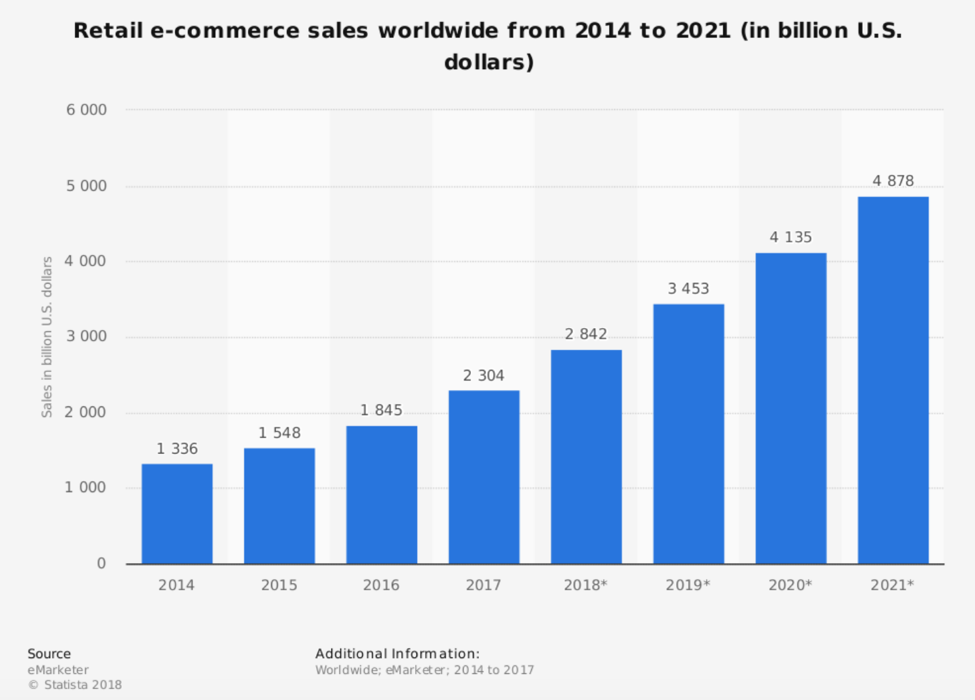
Growing at an average annual rate of 25%, e-commerce is one of the most lucrative industries in recent history, and it doesn’t show signs of slowing down. With the boost in online sales triggered by the COVID-19 pandemic, e-commerce is about to get even bigger, and it’s now almost impossible to see a business surviving without incorporating an online shop into their retail strategy. But while the 2 billion people that shop online paint the picture of a thriving market where you sit back and let the magic Internet fairies do all the work for you, in reality, things are not that simple. Setting up an online store is easy, but managing it and making sure it reaches its full potential requires attention to detail.
E-commerce is actually a fiercely competitive field, and it heavily relies on what’s going on with technology. From responsive web design and voice assistants to AI and machine learning, almost every tech innovation in the past ten years has impacted e-commerce one way or another, so it’s important to watch out for trends and industry best practices. At the same time, customer preferences and behaviors are constantly changing, influenced in their turn by the social and cultural context of the time.
The future can be full of surprises, but you can stay one step ahead of your competitors by following the best practices and learning about industry trends and shifts:
Emerging markets are maturing and welcoming e-commerce.

When most businesses open online stores, they focus first on their local market, and this makes sense financially. Then, as they expand and can ship internationally, they play it safe and focus exclusively on North America and Western Europe. However, this practice can limit growth opportunities. Though not as glamorous, emerging markets such as India, Brazil, China, and Indonesia can be a solid option for e-commerce, and it is estimated that by 2022, they will have 3 billion online buyers. This astronomic growth is due to several reasons. Economically, emerging markets have seen the growth of the middle class, people with high enough incomes to shop online frequently. At the same time, tech adoption has been incredibly fast in emerging markets, to the point where the infrastructure can’t keep up with it. So, brick-and-mortar stores may be generally underdeveloped, but e-commerce has taken off.
The rise of e-commerce makes customers ask more from physical stores.

Why bother going to the store when you can simply buy the same product in the comfort of your home? Like it or not, e-commerce has raised customers’ convenience standards, and if brands expect them to visit their physical stores, they should make sure the experience is worth it. Despite the advent of e-commerce, traditional retail is still lucrative, but only if brands are willing to innovate. The world’s leading retailers are already setting the trends through unique shopping experiences that include prizes, entertainment, personal shopping assistants, and a lot of personalization.
B2B e-commerce is getting bigger

While the B2C e-commerce sector has been in the spotlight, the B2B sector has been steadily growing and is on track to reach $6.6 trillion this year. It’s not just individuals who want to order online conveniently, but business too, whether they need enterprise software or wholesale office equipment. In the field of B2B e-commerce, requirements are obviously higher, not only in terms of user experience and order fulfillment but also in terms of scalability. Managing the complexity of e-commerce automation and integrating systems and tools is critical for the smooth operations of online stores, which is where platforms like Shopify Plus shine.
The mobile-first approach

We’re not here to tell you that your online store should have a responsive website design. People have been shopping from their mobile phones for years, and just about every business owner knows that their store must have an intuitive UI and UX on mobile. So, what’s changed? User behavior and preferences. A few years ago, people would use their phones to buy things when they were on the go. Smartphones were basically a temporary substitute for the bigger, better screen at home, so e-retailers naturally had a desktop-first approach. Now, however, phones are getting smarter, and screens are getting bigger, so a lot of people don’t even bother turning on their laptops anymore to make a purchase. Research shows that 56% of online shoppers have made a purchase when they were at home, which indicates a shift in favor of mobile devices. So, while you shouldn’t neglect the desktop version of your site, it makes more sense to be mobile-first.
Video and e-commerce will go hand in hand.

It’s no surprise that Internet users are consuming record rates of video content, whether it comes in the form of YouTube videos or Instagram stories. What’s more, 64% of online customers buy a product after watching a video about it. How does this apply to your e-commerce website? There are two possible directions you can follow:
- Share videos of your products on social media: these can be anything from testimonials to how to’s and presentation videos.
- Include videos of your products alongside images so that shoppers can get an idea of how they look like in real life. This is especially useful in the fashion industry (see the ASOS strategy).
AI chatbots are the new personal shopping assistants.

A friendly and helpful store assistant can turn shopping into a memorable experience and boost brand loyalty. For many years, the lack of this shopping assistant made conservative customers stick to brick-and-mortar stores, but that may soon be about to change because chatbots have reached a high level of sophistication. Not only are they able to understand complex linguistic patterns and answer the most common user questions, but also memorize user preferences and make personalized recommendations. The use of chatbots has risen in customer service, and experts estimate that up to 85% of customer interactions will be handled with human intervention within the next two years.




